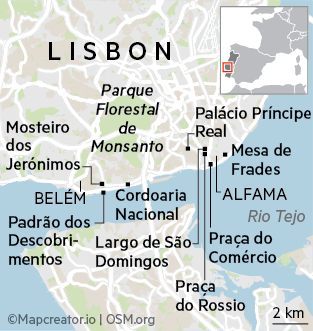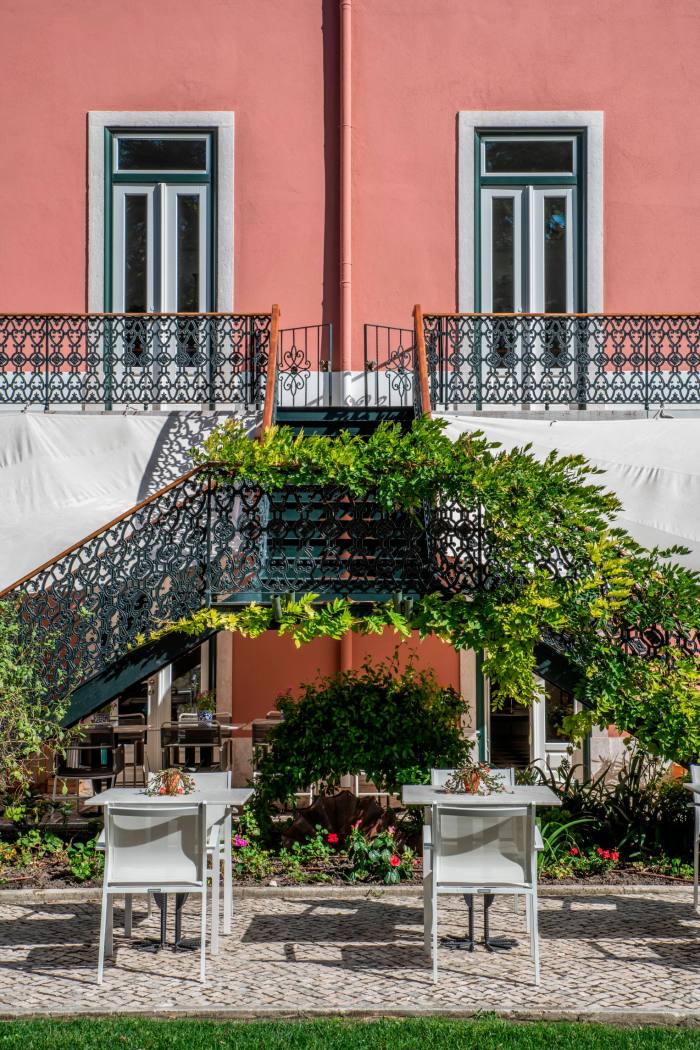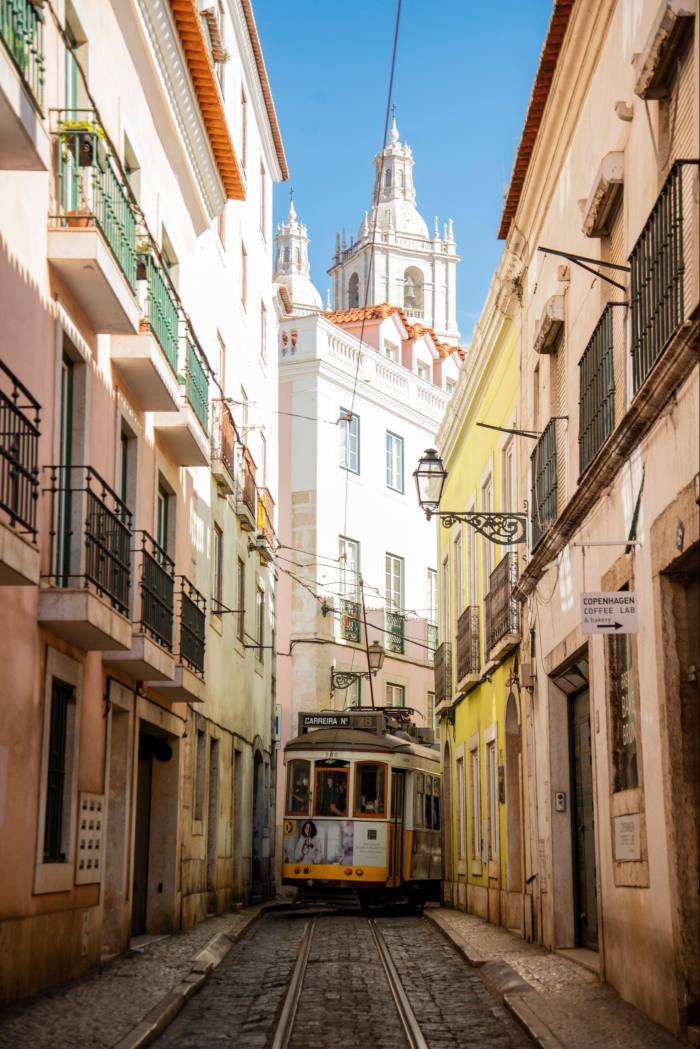All I can remember from that school year — I think I was 10 and living in Ontario — are the maps and a poem. Photosynthesis, parallelograms, Greek myths, the wheat yield of the prairie farms; sadly they have dimmed a bit. But I do vividly remember the dotted lines we drew snaking around the continents, showing the voyages of European explorers. They promised boyish adventure.
The poem, “Cargoes” by John Masefield, set me dreaming as I gazed out of the schoolroom window to the frozen river and the bare trees of a Canadian winter. A ship “dipping through the Tropics by the palm-green shores”, another with a cargo of ivory and apes and peacocks, sandalwood, cedarwood and sweet white wine. It was a more innocent time. Colonialism was not yet a word we used much. The Age of Discovery was still a romance. Now we remember those cargoes were more likely to be slaves than peacocks and sweet wine.

I had come to Lisbon, home to the first start-ups in European exploration before the big players — Spain, France, England — muscled in. In Belém, in the western suburbs, I found the itineraries that I had traced so faithfully in coloured pencil picked out on a giant map of the world on a riverside pavement, part of the Padrão dos Descobrimentos (the Monument of the Discoveries).
The stepping stones of the early Portuguese voyages, decades before Columbus, were carefully marked with dates — Cape Verde 1444, Guinea 1460, the Congo 1483, Cabo da Boa Esperança or the Cape of Good Hope 1488, then onward to Goa in India, Macau in China, East Timor in Indonesia, and across the Atlantic to Porto Seguro in Brazil in 1500. Crowds of Portuguese visitors wandered across the map, their shadows stretching across the continents, as they looked down at the caravels etched in mid-ocean, at the blank spaces of distant lands beneath their feet, at the Portuguese names scattered across the globe.
It was late afternoon. The wide mouth of the Rio Tejo (the Tagus in English) looked like the edge of the world, tipping away into oceans of light. From Belém the Portuguese had sailed from this river mouth and turned left, changing the course of history, in ways marvellous and terrible. Across Africa, Asia and South America, the arrival of Europeans too often heralded a disastrous upheaval. But what of Lisbon? What had been the effect of the Discoveries on this charming city, once the capital of a rickety global empire?
In the past 20 years, the rest of Europe has discovered Lisbon. For centuries, it was the unconsidered capital of an insignificant nation. Then, as the millennium turned, European travellers realised that here on their doorstep was one of the world’s most delightful cities — cobbled streets and labyrinthine lanes, a Mediterranean climate, wonderful food, compelling music, glorious Atlantic beaches 20 minutes from the centre, and custard tarts to die for. And the whole place populated by a modest, easy-going, multilingual people. The middle classes flooded in from northern Europe to snap up gorgeous flats in Alfama and Príncipe Real for second homes and Airbnb properties. Overnight, it seemed, Lisbon was in the throes of gentrification, bringing investment, opportunities and soaring property prices.
I was staying in an old palace in the Rua de São Marçal that could have been a metaphor for the city. Built in 1877, the Palácio Príncipe Real was the home for many years to a wealthy family, conservative supporters of the old authoritarian regime that fell victim to the Carnation Revolution in the mid-1970s. As the last remnants of empire — Angola, Mozambique, São Tomé and Príncipe — were struggling with their sudden independence, Portugal was struggling with postcolonial depression. The leftists were in power, Lisbon was impoverished, palaces were no longer the thing. The family sold up and moved away.


For some years the palace served as offices until it was gradually abandoned. For a decade it stood empty until it was discovered by an English couple, Miles and Gail Curley, who have transformed the rambling old palace into Lisbon’s most charming and luxurious boutique hotel. There is a glow about the place, some palpable sense of welcome that dovetails into this city.
Setting off each morning to explore the city, stepping through the gateway into the street that plunges steeply downhill to the river and the passing boats, I was always startled by Lisbon’s light. Everyone speaks about the wonderful light of Lisbon, the way it floods the streets. Scientists have studied it, and seven years ago the Museum of Lisbon even devoted an exhibition to it. It turns out this luminosity comes from multiple elements including the fresh Atlantic winds that sweep the atmosphere, and the river, the wide Tejo, which seems to lie at the bottom of every street, reflecting that beckoning sea light along the old avenues — the same winds and waters that carried away the caravels on those early voyages of exploration.
With a history possibly a little short on triumph and glory, the Discoveries are a big deal in Lisbon, and not always burdened with the kind of guilt found in other countries coming to terms with their own colonial histories. Images of those sturdy little ships are all over Lisbon, like a touchstone of the city’s life — on pavement mosaics outside Rossio station, stamped on the walls of public housing, adorning the napkins in a restaurant in Bairro Alto. The great national epic, the 16th-century Os Lusíadas, the Lusiads, written by Luís de Camões, celebrates the voyages as it weaves myths that echo Homer around Vasco da Gama’s discovery of the sea route to the Indies. As epic narrative, it is compelling. As historical record, it is as innocent and as deceptive as Masefield’s “Cargoes”.
At the National Museum of Ancient Art, a weather-stained 17th-century palace built by the first Count of Alvor, former viceroy of India, I met the deputy director, Anísio Franco, and we talked about globalisation. As I followed Franco through the vast halls, crowded with syncretic artefacts — Chinese vases with Portuguese figures, European chairs with ivory inlay, cabinets in Indo-Portuguese style with legs of snarling tigers and naked women, a small figure of the good shepherd in a Buddha-like pose — he spoke of the way those early voyages prompted a cross-fertilisation of culture and ideas, a beneficial exchange between east and west. It was a cultural rather than a political thesis.
Of course, it probably helped if you were Japanese, rather than African. We came at last to the room containing the famous Namban screens — lacquered Japanese screens depicting the arrival of the Portuguese in the port of Nagasaki in 1543. Moored among golden clouds in a festive atmosphere, the Portuguese caravels are surrounded by scenes of arrival and departure, wild-horse races and stately elephants, sailors clambering among the ship’s rigging, men carried to and fro in litters, cargo loaded and unloaded, curious crowds gathering to witness the spectacle. It is a thrilling work of art, recording a key moment in global history, a fateful early encounter of east and west, depicted exquisitely by the Japanese as a rather jolly occasion.
But attitudes to the arrival of the Europeans would soon sour, even in Japan. For two and a half centuries from the early 1600s, the Japanese decided cultural exchange was not all it was cracked up to be and closed their ports to foreigners.
In the colossal nave of the 16th-century Church of São Roque, on the edge of Bairro Alto, the benefits of cultural exchange for Portugal are plain to see. The layers of gold here, shipped from the slave mines of Brazil, are blinding and come with elaborate side orders of marble, lapis lazuli, creamy alabaster, rich ruby agate, purple amethyst and yellow jade from across the globe.
Outside in the square, a statue of the Jesuit António Vieira, who died in Brazil in 1697, shelters three native children with pudding-bowl haircuts, loincloths and bone necklaces. A diplomat as well as a missionary, Vieira is still a divisive figure, a hero to the nationalist right, a villain to the activists of Descolonizando, who advocate the decolonisation of Portuguese thinking.
I headed down the long flights of stairs to Praça do Rossio (Rossio Square), then wandered into the Largo de São Domingos, where groups of men sat on benches and steps to chat and gossip. This square has been a gathering place for Lisbon’s African communities for centuries. To one side, beneath the trees, women laid out their roots and spices, spells and potions. A young woman from Guinea-Bissau, possibly concerned about my pallor, sold me a powerful love potion — it will have the girls reeling, she said — that came with a strange bitter nut that I needed to present to any prospective father-in-law.
More places to stay

The Vintage Set on a corner near bustling Príncipe Real, the Vintage has a small but scenic rooftop bar, a relaxing spot to sip rosé after a day of walking the city’s hills. Comfortable rooms with retro décor come with a gin-and-tonic kit, and there is a small spa. Double rooms from €430 per night; the vintagelisbon.com
Le Consulat In the heart of Chiado, this is a beautifully renovated 18th-century Pombaline building that used to be the Brazilian consulate. It has large, bright rooms and is decorated with artworks from Portuguese galleries. Set on busy Camões Square, it is also close to the bars and restaurants of Bairro Alto. From €300; leconsult.pt
Palácio das Especiarias Also in Chiado but more tucked away, the Palácio das Especiarias is housed in a 16th-century building and offers a flavour of when Lisbon was the centre of the spice trade. Sumptuous staircases and lounges, decorated with antiques, resemble sets from a period drama; rooms are named after spices or precious metals. Breakfast comes with live piano or violin music and twice a week there is fado in the lounge. From €228; palaciodasespeciarias.com
Memmo Alfama In the winding backstreets of Alfama, this is one of the best places to watch the sun rise over the river Tejo. The style is casual, with subtle but creative decor. There’s a charming rooftop bar which also makes a good spot for breakfast (despite the cheeky seagulls). From €275; memmohotels.com
Avenida Palace This grand Belle Époque hotel opened in 1892 and sits next to the central station. It has hosted royalty and politicians, and during the second world war, when Portugal was neutral, it was used by spies because of its location and privacy, with a secret door to the station. From €278; hotelavenidapalace.pt
Célia Pedroso
In Belém, the effigies of Vasco da Gama and Luís de Camões, their hands clasped in prayer, lie in the spectacular Monastery of Jerónimos, where the story of the Discoveries becomes stone. The showpiece of Manueline architecture, the monastery was built in honour of Da Gama’s journeys, and its columns, arches, vaults, windows and doors are all adorned with the carved motifs of ships and voyages — ropes, wheels and anchors, entangled among the exotic plant and animal forms of the Orient. The cathedral is dark and brooding, while the cloisters are one of the finest spaces in Europe.
Just along the road is the long facade of the Cordoaria Nacional, where they made ships’ ropes, while not far away is the Pastéis de Belém, the original home of the Lisbon’s famous custard tarts, made possible by the cargoes of sugar and cinnamon that were landed here. They keep the original recipe safely locked in a secret room.
It was late and twilight was descending on the river. I caught the tram back along the waterfront, between the Avenida da Índia and Avenida de Brasília. Like escaped fairground rides, the old clanging trams are one of the joys of Lisbon. Beyond the Praça do Comércio, flanked by government ministries, the tram climbed into the narrow lanes of Alfama. This chaotic bairro is the ancient heart of the city, its name an echo of Moorish occupation. It is where Da Gama’s sailors would have lived, and where so many of them never returned. Alfama is where they set the Discoveries to music.
Fado (which simply means “fate”) is a haunting and elegiac musical form that gives voice to saudade, the Portuguese word everyone struggles to translate. Saudade is a yearning for people and places, for lost times and hopes now out of reach, some moving mix of nostalgia and homesickness. The earliest fados were for lost sailors, and it retains that sense of departure, of loss, of being far from home. To many, it is the voice of Lisbon. When Amália Rodrigues, the great fado singer of 20th century, died in 1999, thousands of mourners lined the route of her funeral cortege, weeping, throwing flowers and singing snatches of her songs as the coffin passed.
There are many mediocre fado restaurants in Alfama, where old women in shawls croak their repertoire. But it is worth seeking out some serious fado establishments — places like Clube de Fado, where you will hear some of the great contemporary fado singers. My favourite was a slightly humbler place, Mesa de Frades, in a tiny sloping square beneath a spreading plane tree.
Once the private chapel of Dona Rosa, the lover of 18th-century king João V, Mesa de Frades is now one of Lisbon’s more bohemian fado clubs. Religious themes, framed by cherubs and draperies, swarmed across the azulejos tiles that lined the walls. Candlelit tables, cluttered with the debris of dinner, filled the tiny nave. The diners, most in their twenties and thirties, leaned forward as a slight young woman in a black dress took her place between two guitarists.
With her hands clasped in front of her and her eyes closed, Ana Sofia Varela leaned like a sailor on deck. The two guitars started — the minor chords of the Spanish guitar and the falling line of notes of the Portuguese guitar, rather like a double-stringed lute. After their four-bar introduction, Ana Sofia tilted her head upwards, and her voice soared into the room, delicate, heartfelt and beautiful. And there for a moment, as the notes hung beneath the vaulted ceiling, was the deepest echo of Lisbon’s history with the sea, with those dotted lines snaking around my coloured map of the world, with the mixed legacy of the Discoveries.
Details
Stanley Stewart was a guest of the tourist board Visit Lisbon (visitlisboa.com), the Palácio Principe Real (palacioprincipereal.com; doubles from €395 per night) and Culinary Backstreets (culinarybackstreets.com), which arranges food-themed city tours. For details on Mesa de Frades see mesadefrades.pt










